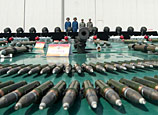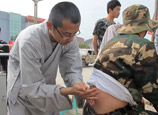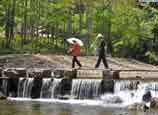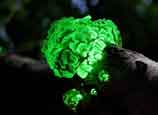
Chinese scientists have discovered that a poultry wet market was likely the source for human infections with the avian influenza A H7N9 virus, and discovered the conditions under which the virus could eventually mutate to human-to-human transmissions.
Collaborative research conducted by the University of Hong Kong and Zhejiang University discovered for the first time that the viral strain isolated from four Zhejiang patients was highly similar to that from the epidemiologically linked wet poultry market, in which about 20 percent of the chickens were infected by the virus.
Research was published in leading medical journal The Lancet Thursday in a paper entitled "Human infections with the emerging avian influenza A H7N9 virus from wet market poultry: clinical analysis and characterization of viral genome," marking a breakthrough in the understanding of the H7N9 human infection.
The research also made important progress on the possibility of human-to-human transmission, an issue of high public concern, analyzing the viral genome.
"We've identified four key amino acid sites and noted mutations of two in the human virus H7, and one in the PB2 gene segment. If another mutation site was found in PB2, it would likely result in effective human-to-human transmission," Li Lanjuan, leader of the research team and professor with Zhejiang University, announced at a press conference Friday.
The two mutations in H7 were associated with increased affinity to human host cells, which could facilitate the influenza virus attaching itself to the respiratory epithelial cells and causing the infection, while the PB2 Asp701Asn mutation is important for adaptation to a mammalian host, according to the research.
Li told the Global Times Saturday that the team would closely monitor the evolution of the other amino acid site in PB2 and raise the alert as far in advance as possible.
In addition, the research found no human-to-human transmission in 303 family or workplace contacts or 82 health-care staff members with unprotected exposure to the four patients.
"The current mutation is unlikely to cause human-to-human transmission, and we are still conducting research about the route of transmission," said Li.
"Genome mutations of the virus take place naturally and the probability for it to form the exact mutation on the targeted site is rather small, but close monitoring remains essential. However, there's no need for the public to panic," Zhou Zijun, professor with the School of Public Health of Peking University, told the Global Times Saturday.
The latest statement from the World Health Organization on Thursday also said that there was no evidence of sustained human-to-human transmission so far.
However, so far, a potential development and outbreak could not be ruled out.
If human-to-human transmission were to become possible, a stringent evaluation about the lethality of the virus on humans would have to be conducted immediately to help determine the best disease control strategy, said Zhou.
Li reminded the public to seek timely diagnosis and treatment if any upper respiratory tract symptoms such as coughs developed, especially as the H7N9 infection can first manifest itself with minor symptoms before rapidly developing. However, the research suggested that the virus is more likely to test positive in the lower respiratory tract and that this was key to screening for infections in the future.
"Patients would suffer from rapidly progressive pneumonia that was unresponsive to antibiotics, and show respiratory failure without proper treatment," said Li.
As of late Saturday, the Chinese mainland had confirmed 121 H7N9 human infection cases in 10 municipalities and provinces, with 23 deaths. An infection case was also found in Taiwan Wednesday.
"But it's statistically immature to determine a fatality rate based on a small sample," said Li.
Latest development of H7N9 in China[Special]
















 Heavy rain affects traffic in S China
Heavy rain affects traffic in S China


![]()
